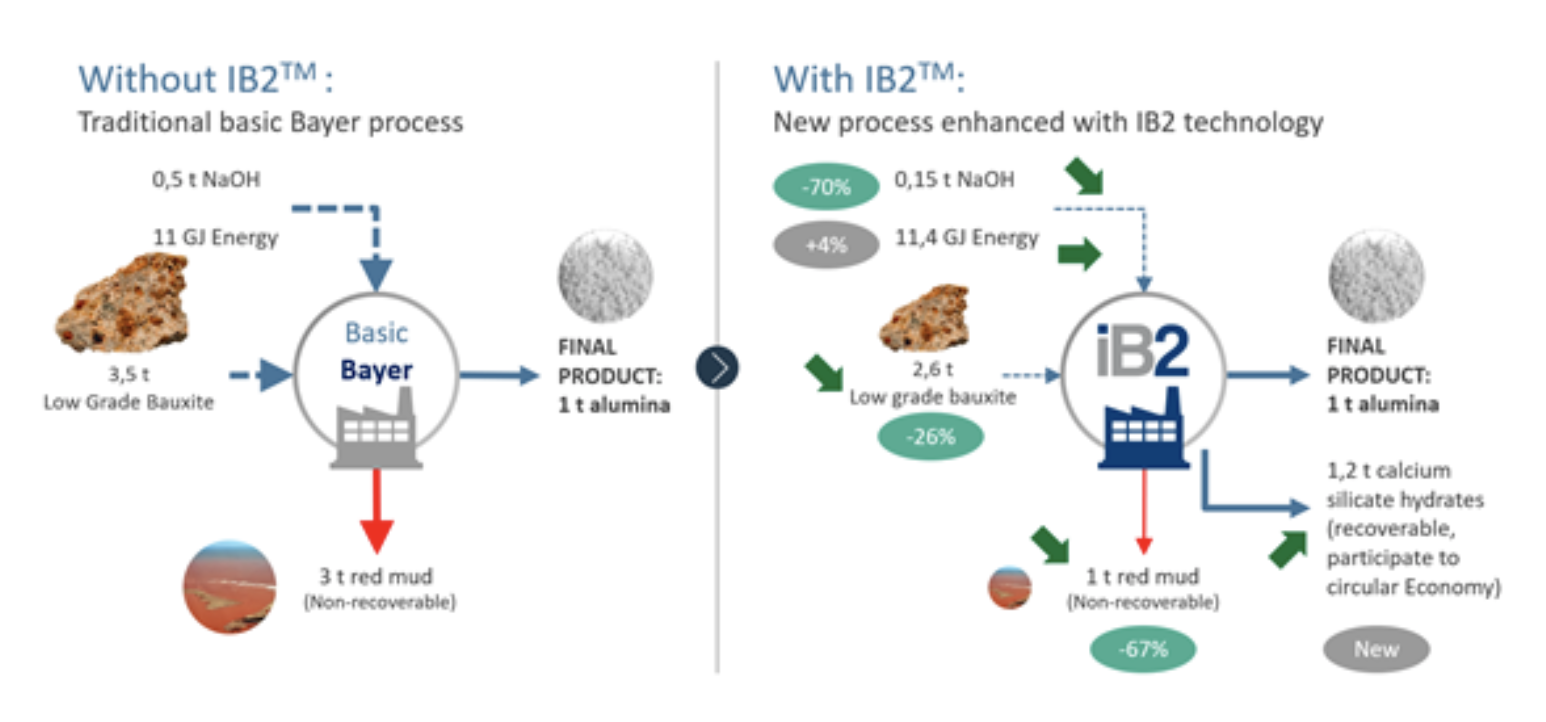For the first time in the alumina sector, a revolutionary French green technology allows for strong financial benefits and unprecedented environmental benefits, while also enhancing circular economy. Let’s find out about the damage caused by the alumina industry and what IB2™ technology is all about. Romain Girbal, general manager of IB2™ will also testify about the benefits of this technology on the environment.
The alumina industry is a source of environmental scandals
To extract alumina from bauxite, the Bayer process makes great use of caustic soda. This produces a waste called red muds that contains highly toxic heavy metals and corrosive compounds.
Romain Girbal, General Manager of IB2 ™ and a member of the Board of Directors specifies: “The problem with low-grade bauxite – cheap to buy because of its poor quality – is that it is very expensive to convert into alumina. Why? Because it requires a lot of caustic soda and potentially polluting products to transform bauxite into alumina. As a result, there is a lot of red sludge.”
Despite considerable research efforts, red muds are not recyclable and generate a significant amount of toxic waste damaging soils, water, and jeopardizing the fauna and flora balance around the world.
“Alumina is one of the most important industrial by-products” confides Romain Girbal
The International Aluminum Institute (IAI) describes red muds as “one of the most important industrial by-products of modern society.” We estimate that more than 160 million tons of bauxite residues are produced each year. This figure will rise to 250 million tons by 2030, with a combined stock estimated at 3 billion tons. The ever-increasing production of red muds is one of the most serious environmental threats in the world of manufacturing industry.
Romain Girbal explains: “IB2™ represents a unique opportunity for countries like China, Saudi Arabia and Kazakhstan to be able to use their local low grade bauxite, while making bigger margin and producing less red muds. Very often these low grade bauxites are not included into the possible mining reserves because refineries without IB2™ are struggling to use them”.
Environmental damage caused by red muds affects the entire planet
The first environmental scandals occurred in the south of France in the 1980s but red muds continue to make headlines. In 2010, a dam spill at the Ajka refinery in Hungary killed 10 people. In China, factories have been forced to close due to fears that red muds spill into the drinkable water system and contaminate local rivers and crops. In 2016, two villages were covered by red muds after a dam collapsed, releasing 2 million m3 of red muds.
The refineries that use the Bayer process are often forced to import bauxite from Australia, Guinea, or Indonesia. This can mean journeys of 20.000 km by sea to China and about 1.000 km by truck to deliver the raw material inland.
Romain Girbal adds “Traditionally, transportation is done in huge ships that pollute enormously. Some refineries have to travel hundreds or even thousands of kilometers by truck to pick up the bauxite at the port and bring it back to the refinery. The consequences are terrible. Noise, dust, accidents and greenhouse gas emissions are really harmful to the environment.”
Is there a better solution for the environment?
Some alternative techniques exist but are generally implemented combined with a conventional Bayer process, involving additional consumption of energy and raw materials (lime, chemical reagents, water, etc.), which increases operating costs and results in additional environmental damage.
Romain Girbal confides: “ The reality is that until now, no green technology had been invented to address the fundamental environmental problems in the aluminum sector: preserving land, crops, and rivers from destruction, avoiding ore transportation over tens of thousands of km across oceans and lands.”
IB2TM is “The Tesla of Alumina” according to Romain Girbal
IB2™ is a green technology revolution. It was developed and patented in France. The technology not only allows for significant financial benefits, but it also participates in the circular economy while being a fantastic environmental revolution.
Romain Girbal confirms: “IB2 ™ is probably one of the deepest green revolutions in the manufacturing industry.” He continues: “The impact of IB2 ™ can be compared to the revolution of the electric car for the combustion engine. IB2 ™ will be the Tesla of alumina.”
Romain Girbal explains the principles of operation IB2™

Romain Girbal clarifies: “As a first step, IB2™ will process the low grade bauxite into its roasting unit, after that a few confidential processes are applied before having a high grade IB2™ bauxite coming out of the IB2™ unit. This higher grade IB2™ bauxite will then go into the refinery where IB2™ will slightly improve the bayer process for more efficiency.”
When it transforms bauxite into alumina, IB2™ technology creates a “co-product” called CSH. Romain Girbal specifies “ It is a “co-product” that was not created before the existence of IB2™ technology and is used in particular to manufacture cement. This is what we can call a “circular economy”. You create a product that wasn’t even supposed to be created at zero cost and that will be reused. Basically it was supposed to be a waste product, but thanks to the IB2™ technology, a large part of the waste is used by the cement manufacturers”.
Romain Girbal introduces the environmental benefits of IB2™ technology
Here are the main environmental benefits of IB2TM technology
1. Only IB2TM technology can reduce red muds production by about 65%, caustic soda consumption by about 70%, as well as significantly reduce water and flocculant consumption.
2. The IB2TM technology breakthrough reduces bauxite raw material needs by about 25% because it requires less raw bauxite to produce the same amount of alumina.
3. Imports of bauxite from Australia, Guinea or Indonesia to China account for millions of km of transport by sea and land generating CO2 emissions amounting to billions of tons per year. IB2TM technology will considerably improve the environmental impact of transportation by reducing bauxite imports.
4. What used to be considered mining waste using the normal process can be considered exploitable ore with IB2TM technology. Indeed, IB2TM increases the useable bauxite reserves and, as a matter of fact, the lifetime of existing mines and national resources.
5. IB2TM technology fully participates in the circular economy. It co-produces Calcium Silicate Hydrates (CSH), which could be reused in the cement industry (and thus reduces the environmental footprint of this industry), for water treatment processes or for civil engineering. Research is currently underway to confirm these applications.
Romain Girbal is confident about the future of IB2TM
One of the major challenges over the next 30 years will be to reconcile human activities with the pillars of environmental management: sustainability and circular economy. Such challenges are crucial to the industry sector.
IB2TM is currently in the industrialization phase and in discussions with the industry actors and strategic investors to start the first plants within the next 12 months. The first clients have shown a great interest in technology and are seriously working a plan to integrate it in their development plan for the next years.
Romain Girbal is confident: “We will definitely bring our contribution to improve the aluminum industry environmental footprint in 2021.”
Contact Media
Laurence Roman as lroman@ib2-bauxite.com




































